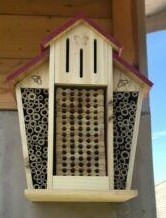Crafting Your Own Mason Bee Home: A DIY Guide to Choosing Suitable Materials
- Understanding the Role of Mason Bees in Pollination
- Importance of Providing Proper Habitats for Mason Bees
- Choosing Natural and Safe Materials for Mason Bee Homes
- Evaluating Wood Types: Pros and Cons of Cedar and Pine
- Utilizing Bamboo and Paper Tubes for Nesting Chambers
- Incorporating Mud or Clay to Aid in Mason Bee Nesting
- Ensuring Easy Access and Protection from Predators
- Step-by-Step Guide to Assembling Your Mason Bee Home
- Tips for Placing Your Finished Mason Bee Home Effectively

Can I Make Mason Bee Homes out of Bamboo?
Annie of Tahoe writes:
I want to make mason bee homes. I plan to try drilling a wood block, but also try bamboo. Since moisture is an issue with bamboo, has anyone tried drying the bamboo out in a low temp oven? Do they have suggestions about how long and at what temperature to dry the bamboo?
I live in the SF Bay Area; during the time we are supposed to be storing the cocoons for next year, are they affected by temperatures? Summer heat, winter chill? Do they need to be kept in a refrigerator?
Also, regarding lining the wood block with paper tubes, any particular kind of paper? Does parchment or wax paper work? What about freezer paper?
Rusty Burlew replies:
Most bamboo websites recommend drying bamboo very slowly. Sun-drying seems to be the method of choice, although it can take 6-12 weeks. Quick-drying causes the surface layers of cells to lose moisture and become stiff before the inner cells have a chance to dry thoroughly, leaving you with dry walls surrounding a wet interior. Over time, the center moisture will migrate out into the tube, the very thing you are trying to avoid.
If you choose to dry the bamboo in an oven or kiln, keep the temperature at 100-110 degrees F. Some websites recommend heating the oven to these temperatures before inserting the bamboo. Once the bamboo is in there, turn off the oven but leave the light on to keep the oven slightly warm. Drying with this process should be complete in several days.
To complicate matters, some bamboo specialists recommend the bamboo be soaked in water before it’s dried. Soaking dissolves any starches and sugars in the stem that may later attract insect predators such as beetle larvae. Soaking to remove starch takes about 12 weeks.
One way to control moisture in mason bee tubes and drilled tunnels is to line them with an absorbent type of paper. The paper then absorbs any water that enters the tube or is generated by the bee’s respiration. This wicking action protects all life stages of the bee from getting soggy. You can cut strips of paper to the correct size and then wrap them around a pencil or similar object to shape them.
As far as paper choices go, wax paper is definitely not absorbent as it is coated with wax on both sides. Freezer paper is treated with plastic on the inside to prevent moisture loss, so it too is unsuitable. Parchment is made with non-stick cellulose, which, although better, is still somewhat water-resistant. Avoid plastic of any type and any other material that is non-absorbent.
Many people prefer low-quality printer paper for this job. The lower the quality, the more absorbent it is, which is why bubblejet inks often bleed on cheap paper. You can take a sheet of printer paper and cut it in half along the length to get two sheets of 8½-by-5½ inch paper and wrap these around a pencil or dowel to give you 5½-inch tubes. Other people prefer brown kraft paper, which also works well.
As far as temperatures, the ideal temperature for storing mason cocoons is just above freezing. This is why household refrigerators are popular storage spaces. Because I’m further north, I store mine in a shed that’s heated to 40 degrees F in winter, which isn’t much different from a refrigerator.
The bees can handle short periods of freezing, but they don’t do well in extremely cold environments or during prolonged freezes. It’s impossible to say the exact temperature that’s best because your local mason bees will have slightly different requirements than those in other places. In fact, if you intend to set up your housing for wild types, they may be entirely different species than the ones that are sold and shipped. That’s also one reason why locally adapted bees will do better than purchased ones.
Mason bee cocoons should also be kept out of extreme heat. They should be kept out of direct sun, even in the summer. If the cocoons warm-up prematurely in the winter, the bees may emerge before their host plants. It’s best to put out the cocoons in very early spring so bees and plants are subject to the same warming trends and emerge/blossom at the same time.
Leave your email address in the comments section if you would like to get the monthly newsletter from beewhisperer360.
